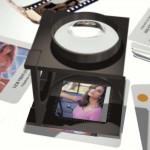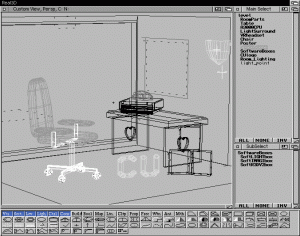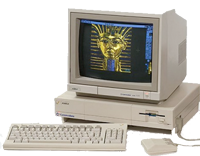3D Spectacular (CU Amiga December 1994)
Real 3D
 Real 3D approaches the 3D world from a totally different perspective (no pun intended). True CSG is employed along with b-spline freeform modelling. What this equates to is Boolean operations that work and smooth surfaces without any faceting. Interesting side effects are that lenses can be modelled realistically.
Real 3D approaches the 3D world from a totally different perspective (no pun intended). True CSG is employed along with b-spline freeform modelling. What this equates to is Boolean operations that work and smooth surfaces without any faceting. Interesting side effects are that lenses can be modelled realistically.
The package still offers polygon capabilities, but not in the same way as any other package I have used. There are many different ways of making and manipulating polygons in Real, and it’s beyond the scope of the review to go into them here. It’s slightly immaterial as Real’s true power lies in b-splines. Imagine any surface and with time, patience, skill and Real you can create it. For freeform modelling, no other package is quite as powerful.
The way objects are linked together in Real is unique, too. Forget grouping or parenting, a true heirarchical system lies at the heart of Real. Objects can be put into levels in much the same way as files can be put into directories. Anything above the current level in the heirarchy is a parent, so actions taken on the parent affect the children. Levels play a vital part every part of Real, including boolean operations and animation features.
Real allows no limit on the amount of texture maps placed on an object. These maps can be parallel to a user defined plane, spherical, cylindrical, non-directional, circular or can be made to follow any b-spline surface.
Different “handlers” for different aspects of the texture can be controlled using mathematical formulae, Real’s FORTH-like RPL language and more. Flexibility over textures is the impression I’m trying to get over.
Animation in Real is, none too surprisingly, completely different too. Think of a way of moving an object and Real will probably have it. Briefly, Real allows “methods” to be defined, and there are currently 26 on it’s list. Of course, things can follow a path (and be made to rotate to follow the path too), but so much more can be done. Sweep will gain many friends as it allows a pivot point to be defined for an object (or objects) and then the motion of the other end of the object to be defined. To model a leg walking is simple with this : the hip is the pivot point, and the knee moves in an ellipsoid path. The heirarchical level system aids further the leg model : create a level inside the hip level with the shin moving (pivoting at the knee and sweeping at the foot) and you’re there.
Real’s animation system is extremely powerful and exploits the heirarchical system of real perfectly. Again, a full description of the system would take pages and pages and pages. Another feature of it worth mentioning is that it is a true particle system with collision detection. Collisions are still only around 80% accurate but are much better than what the others offer (ie nothing).
Real, like the other two, supports bones. The joints of the skeleton allow fidelity and friction to be changed, controlling how accurately the object follows the bone at the joint. Bones are a very well implemented part of Real and are refreshingly simple and powerful.
Rendering controls are all there too. If b-spline objects are taking too long to render, the option exists to convert them into as many polygons as you want for rendering. Renders of any size can be put out to a file, window or directly to 24-bit boards. Depth of field is available, as is antialiasing (to different levels) and motion blur. It’s worth mentioning that Real’s soft shadows (or penumbra) are true shadows and are correctly formed, unlike LightWave.
Finally, Real’s user interface is completely configurable. It can be made to run on any available screenmode with whatever configuration of windows you require. This, contrary to what some people think, is not a bad thing. Your workplace can be exactly how you want it : triview or single view, single or multiple select windows (for picking objects out of levels), as many tools as you want on screen and much more. Along with being able to make objects wireframe invisible, you can make Real a very nice place to work.



1 Response
[…] baud modem on my Amiga 500 attached to a floor-standing TV. Even then, I spent hours learning Turbo Silver on the fantastic Motorola 68000 based workhorse in my living room. What are these […]